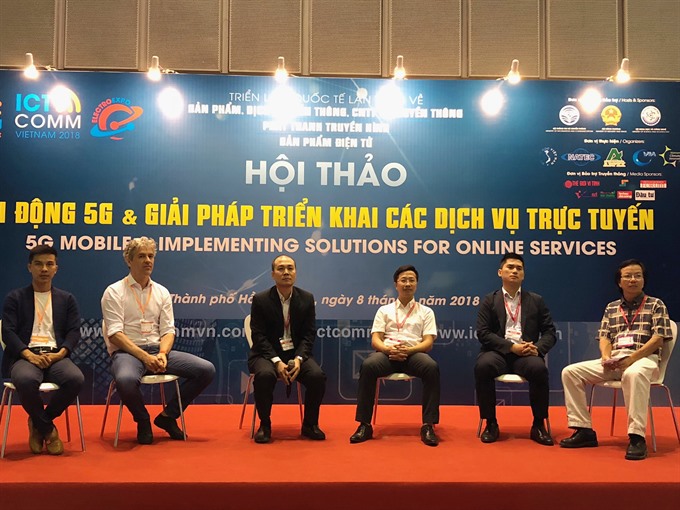 Economy
Economy

In one or two years, 5G technology will be ready for deployment in Việt Nam, according to Ericsson’s head of network solutions in Việt Nam, Laos, Cambodia and Myanmar.
 |
| Speakers at the seminar on 5G Mobile and Implementing Solutions for Online Services held in HCM City on Friday. — VNS Photo |
HCM CITY — In one or two years, 5G technology will be ready for deployment in Việt Nam, according to Ericsson’s head of network solutions in Việt Nam, Laos, Cambodia and Myanmar.
Speaking at a seminar in HCM City on Friday, Lars Werner said that 5G is the next step in the evolution of mobile communications and will be a key component of the networked society.
Previous generations of mobile networks addressed consumers predominantly, while 5G will serve consumers and multiple industries.
5G offers massively improved data throughput, low-power networks to support Internet of Things (IoT) and much lower latency (the delay between sending and receiving signals) to enable clever remote-control scenarios.
5G also provides wireless connectivity for a wide range of new applications and use cases, including wearables, smart homes, traffic safety/control, critical infrastructure, industry processes.
As a result, it will also accelerate the development of the IoT.
For instance, 5G networks offer manufacturers and telecom operators the chance to build smart factories and take advantage of technologies such as remote control of robots, automation, artificial intelligence, and augmented reality for troubleshooting, according to Werner.
In healthcare use, 5G will enable precision medicine, remote robotic surgery and ambulance drones, he said.
“We expect that four to five years from now, there will be 30 billion connected devices worldwide.”
“5G is needed because you will see a tremendous growth in data and in IOT devices, and the existing system will not be able to handle everything. That is why 5G will come.”
The potential for deploying 5G technology in Việt Nam is good because operators in Việt Nam have already launched 4G.
“We see here (at the seminar) that VNPT set up a smart connectivity platform. If we move forward one or two years, 5G will be ready here in Việt Nam,” he said.
Last year, his company in collaboration with the Authority of Radio Frequency Management (ARFM), organised a demonstration of 5G in Việt Nam.
5G is now being used in other countries, including Japan and Korea, he said.
Smart city
The seminar also discussed smart city development in Việt Nam.
Phạm Huy Hoàng from the Vietnam Posts and Telecommunications Group said that fast urban development had resulted in overloaded infrastructure and public services in many big cities.
Plans are being made to turn them into “smart” cities to improve the life of citizens, and detect, prevent and respond to problems as well as promote economic growth, attract investment, and develop green and sustainable cities.
Four factors that define a smart city include: the application of a wide range of electronic and digital technologies to communities and cities; the use of information and communication technology (ICT) to transform life and working environment within the region; the embedding of such ICTs in government systems; and the territorialisation of practices that brings ICTs and people together to enhance innovation and knowledge that they offer.
VNPT has developed smart city solutions in digital government, healthcare, education, safer city, agriculture, transportation, tourism, environment, and ICT infrastructure.
It is also working with cities and provinces and local enterprises in developing smart cities, he said.
To successfully develop smart cities, it needs the co-operation of citizens, enterprises and the Government, he said.
Bùi Quốc Việt of the Việt Nam Association for Information Processing said that plans to develop smart cities are needed in large cities first, and then they can be expanded to other localities, with initial focus on solving urgent issues such as transportation, urban and land management, and healthcare.
The seminar was organised by VAIP on the sidelines of Vietnam ICT COMM, an international telecom, IT and communications exhibition held at the Saigon Exhibition and Convention Centre from June 7-9. — VNS




